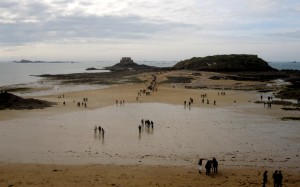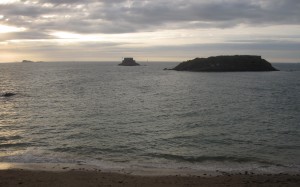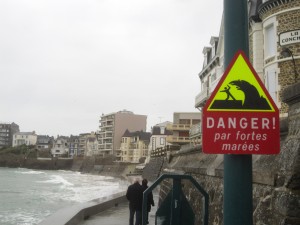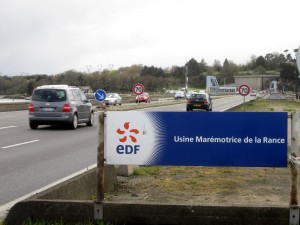My last post was left hanging on the edge of a discussion on energy and innovation. So, I’m going back to Saint-Malo in this post to pick up where I left off. One of the details I didn’t discuss in depth before was that the tides in Saint-Malo are ridiculous. At high tide, whole worlds are hidden under smooth glassy waters, the rocks and barnacles and mussels waiting until another low tide to be visited and explored. It makes sense, because Saint-Malo shares the same extreme increase and decrease in sea level seen at Mont Saint-Michel, which I’ve written about before. (It’s the place that is sometimes an island in the English Channel, and sometimes in the middle of sand planes with no sea in sight.)
So powerful are the tides that signs warning you of their intensity are seen all over the city. This sounds scary, but don’t worry: it’s only the moon drastically effecting life here on Earth from hundreds of thousands of miles away.

These signs have actually become rather endearing to me, because I so associate them with Saint-Malo.
So, what does all of this moon-water-yoyo-magic have to do with energy and innovation? Well, in the Bay of Saint-Malo is one of the world’s few tidal power stations (and the first one ever made, if I understand correctly). Joey and I got to walk across the station, which is a bridge on top, while in Saint-Malo.
Before seeing it, I had ignorantly imagined that it would use some kind of floatation system, going up and down with the water. You know, colorful plastic floating things. However, it basically resembles a dam, letting water pass through horizontally (not using plastic floaties to do it vertically).
Of course, tidal power doesn’t exactly satisfy the energy needs of France. These are mostly met by nuclear power, in which the country has had a strong interest ever since Charles de Gaulle pursued status for France as a nuclear power after World War II. I was told they get around 60 percent of their energy from nuclear, but upon checking with the World Nuclear Association I found it’s actually over 75 percent!
While some European countries have back-lashed against nuclear (in favor of renewable sources), France is still very committed to it, with the recognition that they are not yet in a place to meet all of their energy needs with renewable sources. This is in contrast to Germany, which closed down too many of their nuclear power plants, and then had to buy electricity from France (guess what kind of electricity that was…). I think the French find this slightly funny.
When it comes to wind energy, there are some among the French (certainly not all though) who are against it because they fear it would devalue the landscape. For example, the above mentioned island in northern France (which masquerades as not an island at low tide) is a UNESCO world heritage site. But it’s not just the island that’s important, it’s the view of the stunning country that surrounds it. Would it be the same if covered with wind turbines? Perhaps not.
Regardless of opinions on wind turbines, some of the most important marks of attitudes on energy and environment in France are in the small details. During showers, it is quite common to turn on the water only when needed, not leaving it run the whole time. The hostel where we stayed in Saint-Malo did this automatically: it was on a timer that you had to keep pressing if you wanted to keep the water flowing. To save wasting on flushes, many toilets have two flush buttons: one for more water, and one for less.
People also leave lights on in an unoccupied room much less frequently than in the United States. And when not needed, it seems to me that buildings here have more windows that make better use of sunlight (and sometimes the electric lighting is mediocre: a gentle reminder that if the sun has gone to sleep, it’s probably time for you to do the same).
I love France, and can sometimes be biased towards it. However, I approve of their energy practices above and beyond that bias. They have personal habits of conservation, and experimenting with new forms of renewable energies, but they also recognize nuclear as the bridge between fossil fuels and renewables. In addition, this gives them a great deal of energy independence as well as a tiny carbon footprint. When American’s talk about energy independence, the conversation usually revolves around the ridiculous assumption that we can achieve it with domestic oil. Even if that weren’t ridiculously optimistic, it won’t last. France has realized that nuclear is the best option–at least for now.




